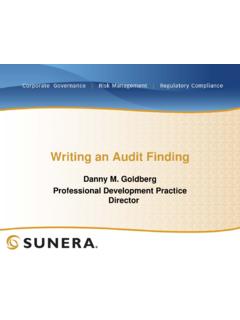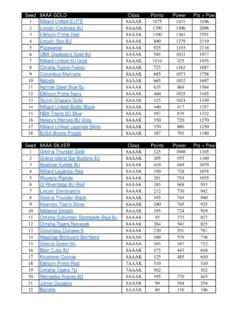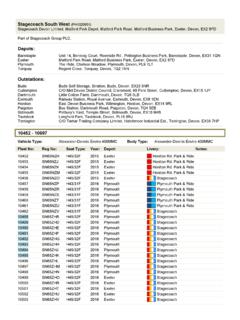Transcription of Competing on Analytics
1 Executive SummaryThis report describes the emergence ofa new form of competition based on theextensive use of Analytics , data, andfact-based decision making. The Analytics quantitative or statistical models to analyzebusiness problems may be applied to avariety of business problems, including cus-tomer management, supply chains, andfinancial performance. The research assessed32 firms with regard to their orientation toanalytics; about one-third were classified asfully engaged in analytically oriented strate-gies. Both demand and supply factors foranalytical competition are described. Of thetwo, demand factors are the more difficultto create. The presence of one or morecommitted senior executives is a primarydriver of analytical competition. On What Basis DoCompanies Compete Today?
2 In virtually every industry, many formerstrategic alternatives are no longer viableor likely to be successful. Today, thereare few regulated monopolies, or compa-nies with unique geographical technologies are rapidly copiedby competitors, and breakthrough inno-vation in either products or services israre. Most of the competitive strate-gies organizations are employing todayinvolve optimization of key businessprocesses. Instead of serving all customers,they want to serve optimal customers those with the highest level of prof-itability and lifetime value. Instead ofreceiving goods and services wheneverthey happen to arrive, they attempt tooptimize supply chains to minimizedisruptions and in-process of looking backward at theirbusiness performance and making ex post factoadjustments, they seek tounderstand how optimum nonfinancialperformance drives optimum financialperformance, and to make accurateforecasts of future performance so theycan react in advance of of throwing money at businessproblems, they seek to optimize theiruse of strategies involving optimizationrequire something different than thosebased on taking business as it all, they require extensive dataon the state of the business environ-ment and the company s place within it.
3 And extensive analysis of the data tomodel that environment, predict theconsequences of alternative actions,and guide executive decision , they require analysts anddecision makers who both understandthe value of analyticsand know how best toapply these for drivingenhanced perform-ance. Companies thatstrive to optimizetheir business per-formance usingthis data-intensiveapproach are compet-ing on Analytics andanalytical companies arepursuing optimization-WORKING KNOWLEDGE RESEARCH REPORTC ompeting on AnalyticsTHOMAS H. DAVENPORT, DON COHEN, AND AL JACOBSON MAY 2005 About This ResearchThis research report is based on analysis of32 organizations from a variety of industries(Figure 1) that are successful both in termsof their overall performance and in theiruse of business Analytics .
4 The research wasundertaken to investigate and documenthow and why these companies not only usesophisticated Analytics , but also make themthe basis of their competitive strategies,and adopt or move toward an enterprise-level approach to business or in-person interviews wereconducted with either IT or business execu-tives at 30 firms; three firms were analyzedsolely on the basis of secondary REPRESENTED NUMBERF inancial Services 10 Consumer Products and Retail 6 Travel, Transport, and Entertainment 5 Pharmaceutical and Chemical 4 Information Technology and Communications 3 Health Care 2 Engineering 1 Government 1 Figure 1:Industries of Companies SurveyedCOMPETING ON ANALYTICSBABSON EXECUTIVE EDUCATION WORKING KNOWLEDGE RESEARCH CENTER2based strategies, but most have failed todevelop the analytical capabilities neces-sary to make them succeed.
5 The idea of Competing on Analytics is notentirely new. A few organizations mostwithin financial services and particularly infinancial investment and trading businesses have competed on this basis for trading of stocks, bonds, currencies,and commodities has long been drivenby Analytics . What is new is the spreadingof analytical competition to a variety ofother industries from consumer financeto retailing to travel and entertainmentto consumer goods and within compa-nies from individual business units toan enterprise-wide perspective. Even themost traditionally intuitive industries aremoving in this direction professionalsports teams, for of Boston s sports teams have hadsome enviable success of late, at least inpart because of their analytical New England Patriots football team,for example, won its third Super Bowl infour years.
6 The team uses data and analyt-ical models extensively, both on and offthe field. In-depth Analytics help the teamselect its players, stay below the salarycap, decide whether to punt or go for it on fourth down, and try for one point ortwo after a touchdown. Both its coachesand players are renowned for their exten-sive study of game films and statistics, andHead Coach Bill Belichick peruses articlesby academic economists on statisticalprobabilities of football outcomes. Off thefield, the team uses detailed Analytics toassess and improve the total fan experi-ence. At every home game, for example,20 to 25 people have specific assign-ments to make quantitative measurementsof the stadium food, parking, personnel,bathroom cleanliness, and other vendors of services are monitoredfor contract renewal and have incentivesto improve their Boston Red Sox baseball team is alsoa convert to Analytics (following, in manyways, the lead of the pioneering but lesswell-financed Oakland A s).
7 The abilityto extract knowledge from data presum-ably helped the Sox win the World Seriesin 2004 for the first time in 86 has begun to select players lesson traditional criteria such as batting aver-age, but rather on newer, more subtle factors such as on-base percentage. BillJames, considered the godfather of base-ball statistics or sabermetrics, was hiredby the Red Sox as an adviser. The Soxalso have become more analytical off thefield. Like the Patriots, they map andmonitor key aspects of the fan experi-ence from the decision to go to a game,to the routes taken by fans to the game,to the effectiveness of the cleaning team s management has maximizedrevenues from Fenway Park, the smallestbaseball park in the major leagues, by cal-culating ticket price elasticities, establish-ing an online market for season ticketresales, and modeling revenue increasesfrom adding seats in unused locations(including on top of the Green Monster,the towering left field wall).
8 Analytical competition is not only takingroot in sports. Some soccer teams inEurope also have begun to employ similartechniques. AC Milan, one of the leadingteams in Europe, uses predictive modelsto prevent player injuries by analyzingphysiological, orthopedic, and mechanicaldata from a variety of sources. Bolton, afast-rising English soccer team, is knownfor its manager s use of extensive data toevaluate player performance and cultures and processes areappearing not only in professional sportsteams, but in any business that can har-ness extensive data, complex statisticalprocessing, and fact-based decision mak-ing. Analytics is becoming a primary basisfor competition for these firms. They useanalytical tools to change the way theycompete or to perform substantially betterin the existing business model.
9 The gam-ing firm Harrah s, for example, has chosento compete on Analytics for customer loy-alty and service, rather than on buildingthe mega-casinos in which its competitorshave invested. Its CEO, Gary Loveman,has commented, We use database mar-keting and decision-science-based analyti-cal tools to widen the gap between usand casino operators who base their cus-tomer incentives more on intuition thanevidence. uses extensiveanalytics to predict what products will besuccessful, and to wring every bit of effi-ciency out of its supply chain. AmazonCEO Jeff Bezos notes, For every leaderin the company, not just for me, thereare decisions that can be made by analy-sis. These are the best kinds of re fact-based decisions. At themutual fund company Dreyfus, analysis ofcustomer information defined segmenta-tion that helped reduce fund attrition from22 to 7 percent a year.
10 These companies,and a variety of others, are clearly com-peting on cultures andprocesses are appearingnot only in professionalsports teams, but in anybusiness that can harnessextensive data, complexstatistical processing, andfact-based decision of AnalyticallyOriented CompaniesVirtually every major company uses someform of statistical or mathematical analy-sis, but some take Analytics much furtherthan others. In our research on the topic,we have identified several key attributesof firms that compete on Analytics : One or more senior executives whoare strongly advocating Analytics andfact-based decision making; Widespread use of not just descriptivestatistics, but predictive modeling andcomplex optimization techniques; Substantial use of Analytics approachesacross multiple business functions orprocesses; Movement toward an enterprise-levelapproach to managing analytical tools,data, and organizational skills of these attributes is describedbriefly below: One or More Senior Executivesas AdvocatesThe adoption of a broad analyticalapproach to business requires changes inculture, process, behavior, and skills formultiple employees.







